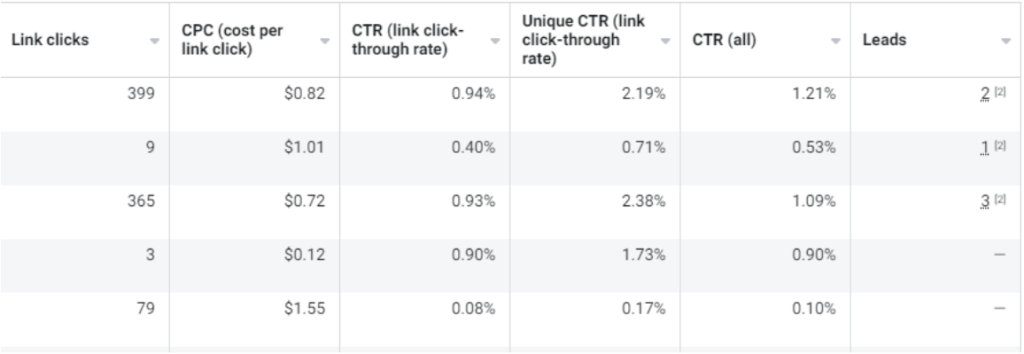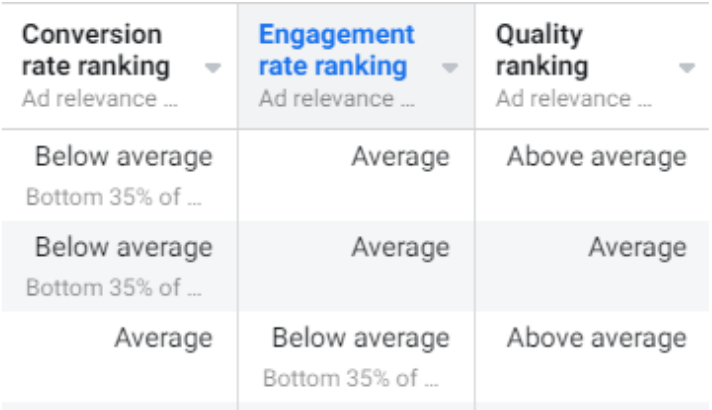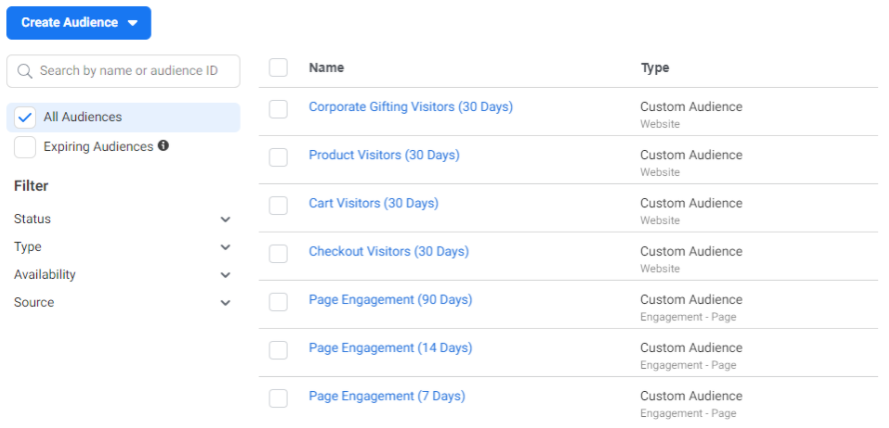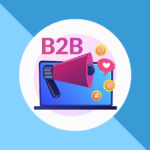Have you ever been browsing on Facebook and come across an ad that you have no idea how it was served to you? It’s not something you’re interested in, it’s not related to your demographics, and the copy leaves a lot to be desired. There is a chance that someone could be having that same experience with your business’ ad. The good news is that there are ways to prevent this scenario from happening.
When a Facebook ad isn’t meeting your advertising objectives you need to diagnose the issue. You don’t need to go far to understand how to know if your ads are resonating – just look in the Facebook Ad’s platform.
How to Check if Facebook Ads Are Resonating
Advertising on social media can play a critical role in your digital advertising strategy. Facebook’s large user base, 2.910 billion, means that it is an ideal platform to reach your customers. A large number of users also means that you have to be strategic in how you target them. With the recent iOS 14 updates, it is important, now more than ever, to use the metrics and information the platform shares to determine the success of your ad.
Facebook Ad Performance Metrics
What sets digital advertising apart from other forms of advertising is the amount of information you can review to discover how your ads are performing. Facebook is no exception to this. The problem is that you can get easily overwhelmed looking into the abyss that is metrics.
The metrics you should pay the most attention to depend on the goals of your campaign. Depending on the objective you’ve chosen, Facebook will optimize for certain metrics. For example:
- A campaign with the Lead Generation objective is designed to achieve the most leads within the budget. It can help you to achieve more leads at a lower cost per lead, but you may see a higher cost per click (CPC) and cost per 1,000 impressions (CPM), and fewer clicks and impressions overall.
- A Reach campaign is designed to reach the most users for your budget. You can expect more impressions and a lower cost per 1,000 impressions (CPM), but you might have a higher cost per click (CPC) and cost per lead, and fewer clicks and leads overall.
- A Traffic campaign is designed to achieve the most link clicks within the budget. You can expect more clicks and a low cost per click (CPC) but might see a higher cost per lead.
Keep in mind that some metrics, like impressions and reach, can be vanity metrics. A huge volume of impressions can be worthless if it doesn’t improve your company’s bottom line. However, focusing on reach and impressions may be appropriate in some circumstances, especially if you’re running a full-funnel advertising strategy with multiple campaigns.

For most advertisers, a good starting point is referencing the Clicks metric. It tells you how many times someone has clicked on your ad – something you want people to do. Low clicks could mean that your content isn’t resonating. If you’re seeing a large number of clicks but no conversions, people aren’t converting, and you should look to your landing page to problem solve.
Once you’ve looked at clicks, you can then take a look at Click-Through Rate (CTR) to figure out how many people interacted with your ad compared to how many people saw it. If you’re seeing a low CTR, it could mean that you need to refine your audiences as they aren’t interested in what you’re offering.
At the end of the day, most of us want conversions. That’s why we run ads in the first place! Conversions show how many people who clicked on your ad went on to become a lead or a customer. If you’re not seeing conversions coming in, you may have your conversion tracking set up incorrectly, or need to go analyze the user experience to understand why they aren’t converting.
Ad Relevance Diagnostics Tool
Like Google, Facebook uses a scoring system to decide how relevant your ads are to the audiences you’ve selected. The platform used to have a quality score but changed it to Ad Relevance Diagnostics in 2019. This tool assesses how each of your ads has performed based on three different areas.

1. Quality Ranking
Facebook uses this to determine how your ad compares to your competitor’s ads that are targeting the same audience.
2. Engagement Rate Ranking
This looks at how your ad’s expected engagement rate is compared to your competitors.
3. Conversion Rate Ranking
This takes your expected conversion rate and compares it to ads with the same optimization goal that competed for the same audience as you.
Facebook breaks down each category into a grade of Below Average, Average, or Above Average. While you might want to go for the second one and be average or above, Facebook has something to consider. They say, “It’s more impactful to move a ranking from low to average than it is to move a ranking from average to above average, so focus on improving low rankings rather than on improving average rankings.”
Facebook has created this handy chart to help you break down what changes to make to your ad to improve your score. This tool gives you a granular look at where you may be experiencing issues by helping to refine your ads. When you increase your rank, you can increase CTR, and lower your cost-per-click.
Optimizing Facebook Ads Performance
Now that you’ve gone through the performance metrics in Facebook and you’ve analyzed the Ad Relevance Diagnostics tool, it’s time to optimize.
This is an important step because the information you discover through metrics and the Ad Relevance Diagnostics tool is useless unless you apply it to your current ad campaigns. While there are many ways to optimize ads on Facebook, we like to look at three different categories as a starting point – audiences, ad creative, and testing.
Optimizing Your Audience

Even with recent changes to privacy and tracking, Facebook still offers some of the most detailed options for targeting the right audience. This makes optimizing your audience an essential part of running successful ad campaigns. If you’re not targeting the right people, they won’t complete conversions and your ad relevance will be poor.
Make sure you’re taking advantage of Facebook’s built-in audiences like Lookalike and Value-Based. These audiences can help you effectively target customers that are similar to yours. When you’re optimizing these audiences, you can get even more granular by taking sections of your large audiences and advertising specifically to a smaller segment to deliver highly relevant ads.
Targeting people who have already engaged with your ads in a strategic way to improve your ad relevance. People who have visited your page, engaged with a post, or sent you a message retargeting people are all opportunities to optimize your Facebook ad campaigns. If you are targeting people who have already engaged with your ad, make sure you’re not targeting people who have previously converted. They might be annoyed when they see your ad which can harm your relevance score. Exclude converters from your ads to make sure this doesn’t happen.
Examine Your Current Ad Creative
When it comes to converting, it’s your creative that does much of the work. It’s important to analyze your creative to make sure that it is optimized for your audiences and aligned with the intent that you want to convey.
An important part is making sure that your ad matches where your customers are in the funnel process. You don’t necessarily want to be showing ads to people with calls for them to make a purchase or get a quote if they are new to your brand. The same can be said for people who have already engaged with your company. If they have engaged, chances are they’re in the next stage of the funnel, consideration. Now would be the time to show ads with calls to request a demo or download a case study.
Facebook users’ newsfeeds are flooded with ads on a daily basis. The key to standing out is strong personalized ads. Don’t be afraid to use the word ‘you’ in your ads to make them more personal to the audiences you’re targeting. Make sure you are using action words like try, get, start, or read in your copy. These words encourage activity and will lead to people engaging with your content and possibly converting. High-resolution images in your ads are just as important as the content you write. People are likely to stop on your ad if you are serving them high-quality images. When optimizing images in your ads, look for bold and contrasting colors to stand out.
Test Your Changes
Finding the right ad to serve your audience is the key to achieving high ad relevance. That’s why it’s extremely important to test the changes that you’ve made. You could implement all the recommended optimizations that we’ve suggested above but they’ll mean nothing if you don’t test them to compare what was successful.
What is great about Facebook is that you can test for many things. You can run tests to compare which audiences were the most successful at completing the action you wanted. Testing is also available for different calls-to-actions to determine which one’s led to the most conversions. When creating new ad creative, you can test different images or layouts to determine which drove the most engagement. You can also discover what time of day is the best to deliver your ads with A/B testing. The options are endless.
The key to using A/B testing is to create multiple ads with different changes or variations to measure the results of each. When you combine multiple changes in one ad it can be difficult to determine what was successful. We recommend creating ads with small variations and then tracking their performance. To start, choose elements that will have a strong impact like images or ad types. You’ll also want to separate these new ads in a separate ad set so that you can track them against current ones.
Conclusion
When you take the time to analyze and optimize your Facebook ads to increase relevancy, the time will pay off. Facebook has shown that it pays close attention to how audiences interpret ads. What you don’t want is for your ad to be labeled as misleading, spam, offensive, or to be hidden by your target audiences. Analyzing performance metrics, using the Ad Relevance Diagnostics tool, and optimizing your ad against A/B testing is the ticket to serving an ad that your audience will engage with.
If you’re striving to achieve a high ad relevance with your Facebook ad campaigns, Ontario SEO can help! We pride ourselves on staying up to date on the latest trends and strategies for pay-per-click advertising like Facebook. Our professionals can help align your business objectives with your Facebook ads to ensure that you are receiving the highest quality of leads.
Reach out to us today to learn how we can help you reach your business goals.








